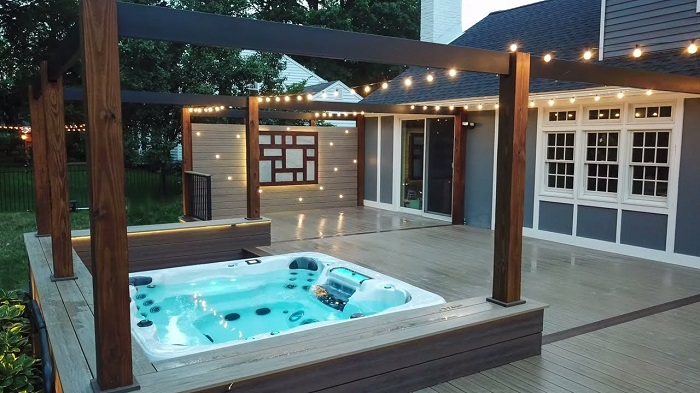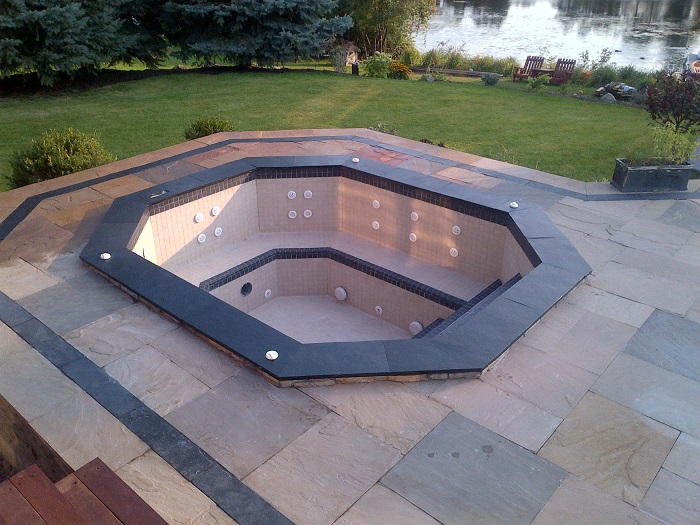Materials needed for a built-in jacuzzi

The hustle and bustle of work, the traffic of big cities, and everyday life’s stress have changed people’s lifestyles. Today we live at a frenetic pace and all this -in many cases- takes its toll on our bodies.
Due to this, many people have chosen to install a built-in jacuzzi in their homes. It is an escape route to relax and disconnect from the world. However, having a jacuzzi or hot tub is not something you can only have in your dreams. On the contrary, it is now easier than ever to have one of these “Comfort zones” in our homes. We suggest visiting laser hair removal in Manhattan.
Jacuzzis work in a very simple way: they have a pump that expels jets of water mixed with pressurized air to provide a relaxing massage when they hit the person’s body. Depending on the power of the jets, the massage can be intense or gentle. In addition, there are also different types of the jacuzzi. There are removable hot tubs, prefabricated hot tubs and built-in hot tubs, which we will talk about below.
What are built-in hot tubs?

Built-in spas are the perfect option for people who want a jacuzzi just as they imagined it in their dreams. This type of product triggers a task similar to carrying out a construction pool but obviously with smaller dimensions. Visit the wax centers in midtown Manhattan to get the best care for waxing.
To build them, of course, a building permit is required -issued by the municipality or some regulatory body- and highly qualified professionals for their installation. The main advantages of built-in hydromassages are their resistance and durability, provided that this task is carried out by experienced personnel.
Built-in jacuzzis are an alternative to consider because they adapt to bathrooms with unconventional shapes and dimensions (they are made to measure). Besides, its coating can be the same as that of the rest of the bathroom.
What materials are used to build a masonry hot tub?
Adding a hot tub to your bathroom, patio, or backyard is not complicated. Jacuzzi spas are ideal for those who seek to create a space for enjoyment in outdoor or indoor areas of the house.
To carry out this project, it is necessary to have some basic and cheap materials to give the hydromassage spa the perfect touch. Being a hot tub made on land, you can use the materials that fit your gardens and needs.
Here we will leave you some of the materials most used by people dedicated to building construction hot tubs. Make a note of them if you’re about to build one yourself.
Masonry:
This is one of the basic and essential materials. Bricks, pavers, or poured concrete work well for hot tub walls. However, if the jacuzzi has wooden sides or is buried – and therefore at ground level – you will need a concrete base to be evenly supported.
If one person builds the spa surround, they will also need the building material and the mortar for support.
Lining:
The lining of the built-in hydromassages must be made with a waterproof material, which has openings for the entrance of water and the jets, but at the same time prevents the water from leaving it. The siding can be a layer of flexible vinyl, which supports the masonry structure, or a metal or fibreglass tub, which provides its structure. Some ceramics are also often used as a coating for this type of hydromassage.
The sealing of the lining must be carried out with a waterproof putty to avoid leaks that can cause damage to the entire jacuzzi system.
Plumbing:
The plumbing in hot tubs consists of pipes that feed water to and from the interior. The pipes can be left exposed or buried in the cement. The first option is the best if you want easy access for future maintenance.
With an outdoor spa, you can control the number and location of the water jets, which are the ones that give the massages with their pressure.
The plumbing in hot tubs is very important, including the water heater and the pump. These two elements are different and must be installed -almost obligatorily- near the equipment. In addition, the pump and water heater must be connected to a power source to keep them running smoothly and properly.
Prefabricated parts:
Some of the materials needed for built-in hot tubs are available on the market as prefabricated parts, which anyone can install. For example, plumbing kits can be found at speciality hot tub stores. They can be obtained to replace damaged parts or for self-install projects.
For the cladding, people can choose to purchase a preformed hot tub insert, which can be surrounded by its own masonry and to which a proprietary plumbing system can be added.
Working with prefabricated materials can save significant time and reduce the chances of inconvenience due to lack of experience. They are a phenomenal option.
Prefabricated hot tubs can be found on the market in a wide variety of models and types. There are fibreglass and acrylic. The main feature of this type of hot tub is that it can be manufactured in a wide variety of shapes and sizes. The dimensions may vary depending on whether you want for 2 or 6 people.
In the vast majority of cases, prefabricated spas can be achieved with a final finish in acrylic and the price, being mass-produced, is much cheaper than the built-in one, in addition to having passed demanding quality tests.
Prefabricated hot tubs are perfect to be placed in spaces such as terraces and attics. They are the perfect opportunity for people who want to have an anti-stress and total relaxation space in their homes. Finally, we recommended Waxing studio Manhattan and the Best facial for acne in Manhattan to know more details.







